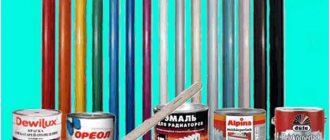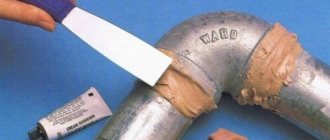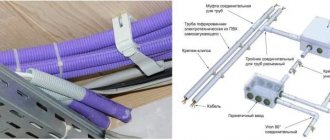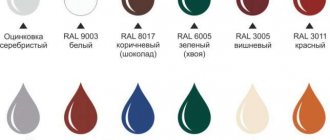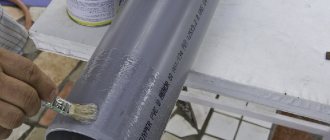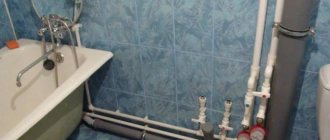New construction technologies for the installation of engineering systems, instead of conventional pipelines made of cast iron and steel pipes, offer much more profitable materials - polymer ones. For example, PVC pipes are increasingly used for sewer networks, polyethylene pipes for water supply, polypropylene pipes and fittings for heating systems. The main indicator is the internal diameter of polypropylene pipes; special attention should be paid to it.
Material properties
Polypropylene is a kind of thermoplastic polymer. It is made by combining (polymerizing) molecules of the derivative gas ethylene. International designation of polypropylene “PP”. Let's take a closer look at the properties and manufacturing technology of this new generation material.
Possessing unique resistance to alkaline solvents and aggressive substances, the material is widely used in the installation of any plumbing structures. Withstands low and high temperature conditions, they can vary from minus 10 to plus 100 C.
Briefly about the main thing
There are 2 types of pipes: metal and plastic. The former are made only from cast iron, and the latter from three types of raw materials: polyvinyl chloride (PVC); polyethylene (PET); polypropylene (PP).
When installing a drainage system, PVC is most often used, which greatly facilitates the operation of the sewerage system. These pipes can withstand heavy loads (road and neighborhood highways), can serve at temperatures down to minus 10 ° C, and are also treated on both sides so that no sediment remains on the smooth surface after rain or mechanical stress. Also, such a pipe can be easily installed in place of an old cast iron one. They come in several types in diameter and are connected to each other by adapters.
| Additionally The exhibition of houses “Low-Rise Country” expresses sincere gratitude to the specialists for their assistance in creating the material. – supplier of water supply and heat supply systems for any facilities, from the world's leading brands. The company also develops and installs automated metering systems for energy consumption. If you need more detailed advice, you can use the following contacts: website: www.makipa.ru email: phone: +7 (495) 134-48-01 |
Ratings 0
Read later
Types of polypropylene pipes and their purpose
Today we offer a huge range of these products. Before purchasing, you should pay special attention to the type of material. It could be as follows:
- reinforced;
- whole.
Based on the technical characteristics, we can safely say that they have a fairly wide range of applications. They are often used for:
- sewerage structures;
- transportation of toxic substances;
- water supply in the building;
- installation of the ventilation system.
Their service life is long, with proper operation it is 50 years. The age of the riser does not affect the functionality and technical characteristics; they are completely preserved.
Cast iron
Such products are used for installing water supply systems outside the building. In residential premises, cast iron water supply is installed extremely rarely. This material has high strength, but increased fragility. Its main disadvantage is its heavy weight and high cost. The operation of such cast iron products is designed for many years.
To compare the sizes of cast iron plumbing products, below is a table showing the dimensions of Class A cast iron pipe.
Marking of polypropylene pipes
The scope of application depends on the material used to make the product. The markings of the elements reflect their technical characteristics.
By pressure
Each material has its own characteristics; the main characteristic by which the area of application is determined is pressure. There are 3 main types - these are:
- for a warm floor system or conducting cold water into the house, part number N10 is used, you can also take a PN 10 pipe. Their pressure is not higher than 10 atmospheres, which allows substances to be carried out without problems;
- model PN25 has a structure that consists of several layers. It increases endurance. For this reason, this type is actively used for installing hot water supply systems in buildings of different heights. Withstands pressure up to 25 atmospheres.
- type PN20 or N20 has a pressure of 20 atmospheres and can withstand temperatures up to 85 - 90 degrees Celsius. Therefore, they are used for any plumbing work.
Pipes can be stored for quite a long time, but they should not be allowed to be near heating systems or devices with high temperatures. This may negatively affect the quality of the material.
Interesting! How to choose a water meter: its installation and saving options
Switching from cast iron to plastic
There are situations when cast iron is installed in the sewerage system and it needs to be changed to PVC. In this case, you must first dismantle the old drainage system:
- Cast iron is cut from the top at a distance of 7.5-10.5 cm from the ceiling, and approximately 80 cm from the tee is left below, the rest is removed with a metal disc. These actions need to be done only until the middle of the structure.
- After this, the rest of the cast iron is removed with a chisel (to do this, it must be inserted into the drilled place and hit with a hammer, then it will fly apart).
- Otherwise, you can take a crowbar or a hammer drill to clear the cement from the pipe, and then use the chisel again.
- After this part of the cast iron is removed, it is necessary to remove the remaining concrete from below and saw off the lower part from the tee, leaving 3-7 cm.
What a joint looks like Source yelpcdn.com
What determines the diameter of a polypropylene pipe?
The first question that arises before designing a polypropylene pipeline is the diameter. It should be selected in accordance with the results of hydrodynamic calculations. The point is to select the smallest allowable pipe size in a particular section. The calculation takes into account the operating pressure and circuit.
Diameter is a value indicating where certain tubes should be installed. If the internal diameter is large (40 - 200 mm), then such polypropylene pipes are used in the construction of structures intended for use by a large number of people (hospitals, saunas, hotels, large stores, entertainment centers).
Plastic
Nowadays, their plastic counterparts have become an alternative to metal pipes. Moreover, their sizes vary widely. The material for such a product is:
- Polypropylene;
- Polyethylene;
- Metal-plastic.
Each manufacturer of such pipes sets its own size chart. Therefore, if one system is being manufactured, it is advisable to use parts from the same manufacturer.
Of course, there will definitely be discrepancies, but they will be minimal and will not cause any particular difficulties for a good master. If a person has little experience, he will have to make some efforts to fit all the sizes.
The table of sizes of plastic pipes for water supply using polypropylene of various densities shows the most popular models.
When all kinds of communications are laid, builders also use other diameters of plastic water pipes.
The diameters of water pipes in the table help you select the appropriate product for repairs or other work.
Table of diameters of polypropylene pipes
The level of transported substances is one of the main parameters that are worth paying attention to. If the indicator is not high, then installations of the type with a small cross-section are made. The higher the level, the larger the diameter of the riser. For smaller buildings, types with a cross section of 1.6 - 11 cm are used. The main characteristic is the internal diameter of polypropylene pipes, it is described in detail in the table.
| External diameter/mm | PN 25 Inner Diameter/Wall Thickness cm | PN 20 Inner Diameter/Wall Thickness cm | PN 10 Inner Diameter/Wall Thickness cm |
| 16 | — | 1,06/0,27 | — |
| 20 | 1,32/0,34 | 1,32/0,34 | 1,62/0,19 |
| 25 | 1,66/0,42 | 1,66/0,42 | 2,04/0,23 |
| 32 | 2,12/0,3 | 2,12/0,54 | 2,6/0,3 |
| 40 | 2,66/0,37 | 2,66/0,67 | 3,26/0,37 |
| 50 | 3,32/0,46 | 3,32/0,84 | 4,08/0,46 |
| 63 | 4,2/0,58 | 4,2/1,05 | 5,14/0,58 |
| 75 | 5/0,69 | 5/1,25 | 6,12/0,69 |
| 90 | — | 6/1,5 | 7,36/0,82 |
| 110 | — | 7,32/1,84 | 9/1 |
Ring stiffness classes
Sometimes in the tables there will be letters and numbers that are unclear at first glance. For example, SN 2 . This is the ring stiffness class. It is measured in kN/m2.
The parameter makes it clear how much the pipe can withstand vertical loads without deformation.
Let's give some brief characteristics:
- SN 2. Withstands pedestrian traffic only.
- SN 4 . Able to cope with passenger vehicles.
- SN 8 . They do not get “flattened” by trucks.
The weaker the soil is compacted, the larger the number should appear after SN .
Section of polypropylene fittings
Speaking about a polypropylene pipeline, one cannot fail to mention the fittings, which are responsible for connecting all its links and forming turns, bends and branches of the pipeline. These elements provide the most exact match, allowing you to implement any heating scheme in practice.
For polypropylene pipes, regular fittings or with a threaded brass insert are used. The first are connected to polypropylene plumbing by diffusion welding, the second are polypropylene, like metal pipes.
Today, the market offers fittings, the sizes of which vary over a fairly wide range, which makes it easy to select the appropriate sample. The choice of internal diameter of fittings for polypropylene pipes determines the operating conditions; it can be 20 or 50 mm.
There are two types of fittings - with and without threaded connections. Threaded fittings are removable and durable. Its type is selected depending on the operating conditions. For example, when connecting a storage tank, a removable threaded fastener is convenient, and when connecting a hose, it is a solid one.
For heating and water supply
There are several ways to supply water to your home:
- on the ground;
- along the top.
Models that have an internal circumference from 16 to 75 mm are suitable for this work.
If installation work is carried out inside a building, then it is better to use a product with an internal diameter of 12 to 32 mm in cross section. Fittings for polypropylene pipes with a cut characteristic of 2 - 4 cm are used for cold water.
When planning the installation of a hot water supply system, you should pay attention to products with a size of 0.2 to 1 cm.
The correct size of the product directly affects the thermal conductivity throughout the building. It is also important to remember that the water heats up to a high temperature, on average it is 100 degrees, so it is better to purchase reinforced models.
For sewerage
In recent years, most builders, when laying sewer systems, use products made from polypropylene. This is due to the fact that they have a lot of advantages and high endurance.
For the design of private houses, types with an external parameter of 32 - 75 mm are selected, for internal work 100 - 110 mm. On an industrial scale, tubes larger than 1.10 cm are installed.
For ventilation
Previously, the ventilation system was created from metal structures; today polypropylene material is preferred. The circumference of their sections varies from 1 to 3 cm if mains are laid for ventilation of the building.
Purpose and main technical parameters
The general international marking of polypropylene pipes is indicated by two capital letters - PP. Polypropylene itself is a modern material based on thermoplastic polymers. Accordingly, it is a product of the chemical industry.
Like all building materials, plastic pipes (PP) have the appropriate state standards (GOST), the technical properties and characteristics of which you can see in the table we attached:
| Name | Measurement technique | Magnitude |
| Density | GOST 15139 | 0.9 g/cm3 |
| Melting temperature | GOST 21553 | 149°С |
| Tensile yield strength | GOST 11262 | 24-25 N/mm2 |
| Tensile strength | GOST 11262 | 34-35 N/mm2 |
| Relative elongation at the moment of reaching the yield point | GOST 11262 | 50 % |
| Linear expansion coefficient | GOST 15173 | 0.15 mm/m°С |
| Thermal conductivity at 20°C | DIN 52612 | 0.24 W/m°C |
| Specific heat capacity at 20°C | GOST 23630 | 2 kJ/kg°C |
One of the most important characteristics of pipe products is their cross-sectional size, that is, diameter. We’ll talk about such a technical indicator as the diameters of sewer plastic pipes (water supply, heating) in more detail.
How to choose the right size of polypropylene fittings for your home line
Those who are faced with the purchase of risers for the first time do not know what internal diameter of a polypropylene pipe is required. Selecting all the design elements will not be any problem, since all products have special markings. All technical characteristics that are necessary for the work are indicated. The buyer only has to carefully select all the accessories according to the same parameters.
It is recommended to buy all elements from one manufacturer, then there will be no difficulties. If the manufacturer of pipes and fittings is different, then compatibility can be checked. You just need to try it on, insert the edge of one product into the other, if it fits tightly, then they fit perfectly.
Polypropylene is one of the best materials; it has many advantages. All designs have high strength and durability. They can be used for private cottages, as well as in apartment buildings.
Standard
There is a special regulatory document for PVC pipes. This is GOST 32413-2013 . It came into effect January 1 , 2015 . The standard “works” not only in the Russian Federation . It is observed by 6 countries:
- Armenia.
- Uzbekistan.
- Belarus.
- Kyrgyzstan.
- Moldova.
- Tajikistan.
The text of the document refers to unplasticized polyvinyl chloride - uPVC. He's harder than usual.

